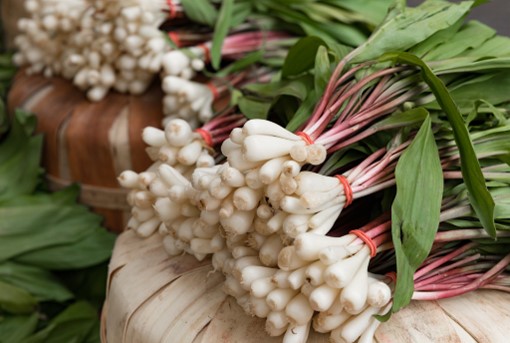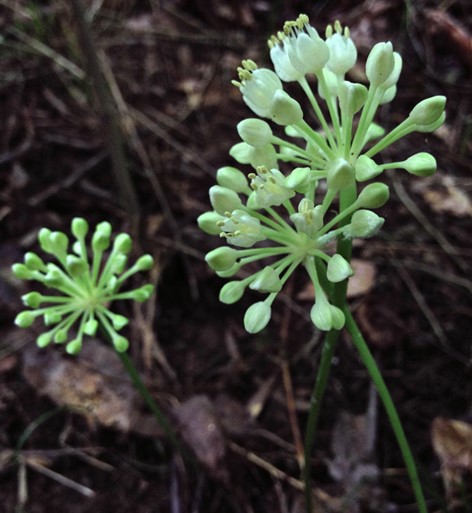Spring is finally here, and one of the first green vegetables to emerge is ramps (Allium tricoccum)!
Many ramps festivals across eastern North America occur this month, including the Cherokee “Rainbow and Ramps” festival on March 25th to celebrate the beginning of spring in Cherokee, North Carolina. This particular event also marks the beginning of fishing season, as well as honoring elders and featuring local entertainment. (See https://visitcherokeenc.com/events/rainbows-and-ramps/ for more information.)

Figure 1. “Wild ramps at farmers’ market (Allium tricoccum)” by Toni Genberg (CC BY-NC-SA 2.0).
Characteristics:
Allium tricoccum is commonly referred to as ramps, spring onion, wild onion, mountain leek, and wild leek and is native to eastern North America, particularly the mountains in the North Carolina/Tennessee area.
They are most likely to be found between slightly swampy mountain meadows and very dry, south-facing foothill slopes. The plant is known for its garlic/onion scent which assists in helping identify it against its poisonous look-a-likes, Convallaria majalis or Veratrum spp.; if uncertain, the best way is to crush the plant and smell it.
Although they can be dried and stored, freshly picked in the spring (gathering season only lasting a few weeks), the ramps only last a few days.
Ramps are members of the Amaryllis family, also known as Amaryllidaceae, although they are more specifically members of the subfamily Alliodeae, otherwise known as the Onion family.
This family is known for having plants that are monocots with conical onion-like bulbs and 2-3 juicy leaves on a purplish stem with small white flowerheads that are wrapped in bracts. The flowers are often also in an umbel grouping, spreading from a single stalk, and appear after the leaves begin to die back. Leeks, chives, garlic, and onion all fall under the genus of Allium.
Ramps have “off” and “on” years in terms of seed and flower production, similar to mast-bearing trees. They also often have difficulty surviving past the seedling stage, as well as difficulty germinating, often taking up to two years to do so from a single black seed. Bulbs of the plant should be planted 3 inches deep in medium-wet to medium-dry soil in partial to full shade, and particularly do well under deciduous trees.

Figure 2. “Allium tricoccom, flower. C & O Canal Park, Montgomery Co., MD. (6/30/13)”. Photo by FritzFlohrReynolds (CC BY-SA 2.0).
Historical Uses:
Ramps have long been used as both a drug and food, with juicy leaves and a bulb. Their medicinal properties are produced by volatile oils, sulfur glycosides, Vitamin C, and antibiotic compounds. For over 12,000 years the Cherokees have ceremoniously gathered the plant. The Cherokee have eaten ramps as a spring tonic, cold remedy, for croup, and also have used the warm juice for earaches. The Chippewa and Iroquois have also used ramps medicinally for spring tonics, fighting against worms, and to make an emetic created from a decoction of the root.
This wild vegetable is a favorite dish, and among the Cherokees they are often made with poke and eggs by cooking the bulbs and leaves. Young ramps can also be boiled, fried, and then eaten. The Iroquois and the Potawatomi also use ramps for food, cooking and seasoning the vegetable and often eating the bulb raw. The Menominee and the Ojibwa have also dried the wild onion after spring collection for later/winter use.
Unfortunately, the seeds of the plant (the only part of the plant that would be able to withstand fire long enough to carbonize and preserve) rarely show up in the archaeological record through paleoethnobotanical analysis. However, because of ethnohistoric accounts as well as modern uses, we know that it has long been utilized/enjoyed!
The Eastern Band of Cherokee Indians’ Natural Resources department has worked alongside the US Forest Service in the past few years to demonstrate the most sustainable harvesting practices for gathering of ramps (cutting the shoots and leaving the roots). There has been a great deal of concern for overharvesting and improper harvesting as ramps have grown in popularity for personal gathering, as well as for commercial/restaurant use. Without encouragement and monitoring of sustainable practices, they could disappear from the landscape.
For More Information:
Elpel, Thomas J. 1967. Botany in a Day: The Patterns Method of Plant Identification, An Herbal Field Guide to Plant Families of North America. HOPS Press. Pony, MT.
Kissell, Desirae. 2019, September 7. “Monitoring Ramps”. EBCI Natural Resources, CPSI. https://cherokeenaturalresources.com/monitoring-ramps/
Moerman, Daniel E. 1998. Native American Ethnobotany. Timber Press, Portland, Oregon.
NC State Extension Gardener Plant Toolbox. https://plants.ces.ncsu.edu/plants/allium-tricoccum/
US Department of Agriculture, Natural Resources Conservation Service. 2021. PLANTS Database. Electronic document, https://plants.usda.gov/home
Visit Cherokee North Carolina. https://visitcherokeenc.com/events/rainbows-and-ramps